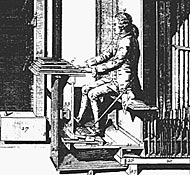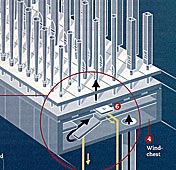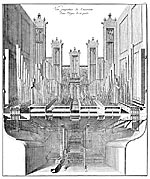How a Pipe Organ Works
Simply Stated…
…the pipe organ is a big box of whistles. Each pipe sits on top of a hollow wind chest that is filled with compressed air provided by a bellows or blower. Each ‘stop’ at the organ console represents a set of pipes (a rank) of a particular tone color, with a different pipe for every note on the keyboard. Pulling the stop activates a slider under that specific set of pipes on the windchest, making them available as a sound-source. The wind chest also contains a series of valves (pallets) connected to the keyboard by a mechanical linkage. These pallets govern the flow of air to each pipe, and even though a stop may be on, no pipes will sound until a key is depressed and its respective pallet opens. This allows the compressed air to pass up through the pipe for that note, creating sound. (see image)
| |
 |
| |
Organist on the bench & an assistant pumping the bellows - Dom Bedos |
Links and resources
Organs are unique
One trombone is likely to look like any another trombone and most violins are virtually identical, but each pipe organ is unique. (Just look at the variations in our gallery.) Each pipe organ is custom made for the buyer, and in every case a number of variables need to be addressed. Considerations for each new instrument might involve the number and types of sounds included, the size of the room where the organ will be placed, the physical look of the instrument and also, the budget.



 The Pipe Organ - Wikipedia
The Pipe Organ - Wikipedia Pipe Organs 101 - Lawrence Phelps
Pipe Organs 101 - Lawrence Phelps How pipes are cast - Martin Pasi (video)
How pipes are cast - Martin Pasi (video) How reed pipes are made - Martin Pasi (video)
How reed pipes are made - Martin Pasi (video) How flue pipes are made - Martin Pasi (video)
How flue pipes are made - Martin Pasi (video) Organ History - description of an organ
Organ History - description of an organ How An Organ Works - Ross King Company
How An Organ Works - Ross King Company Construction of an ancient hydraulis
Construction of an ancient hydraulis Pipedreams Pipe Organ Gallery
Pipedreams Pipe Organ Gallery Encyclopedia of Organ Stops
Encyclopedia of Organ Stops


